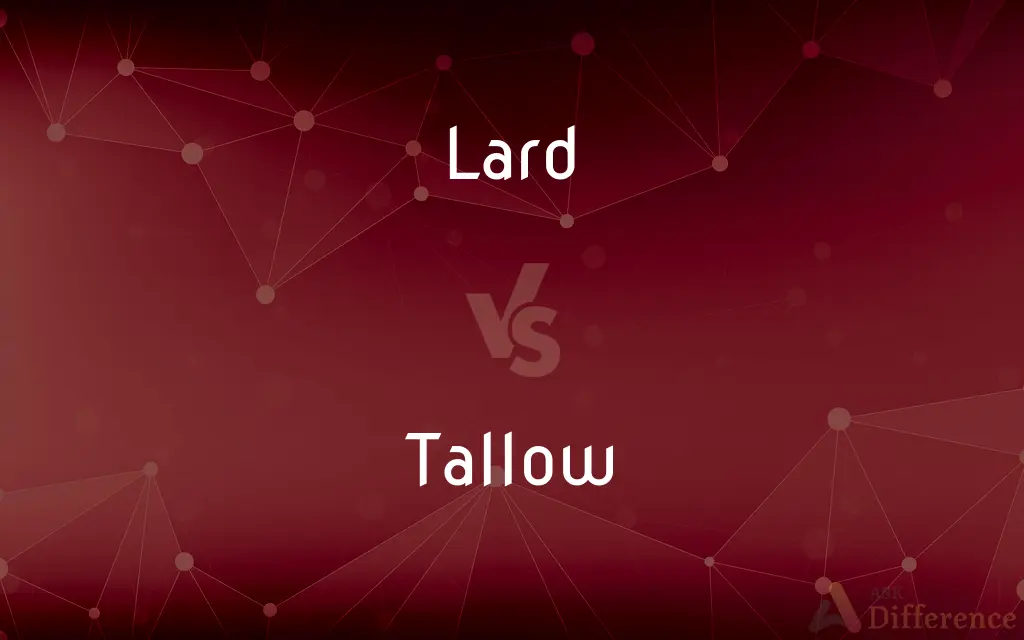Lard vs. Tallow — What's the Difference?
By Fiza Rafique & Maham Liaqat — Updated on March 21, 2024
Lard is rendered fat from pigs, often used in cooking for its flavor, while tallow is rendered fat from cattle or sheep, prized for its high smoke point and use in food and non-food products.

Difference Between Lard and Tallow
Table of Contents
ADVERTISEMENT
Key Differences
Lard is obtained from the fatty parts of pigs, typically the belly, buttocks, and kidneys. It has a soft consistency and is known for its ability to add moisture and a subtle, savory flavor to dishes, making it a favorite in baking and frying. Tallow, on the other hand, is rendered fat from cattle or sheep, with a harder consistency and a higher smoke point, making it ideal for high-heat cooking and frying, as well as in the production of candles and soaps.
In terms of culinary use, lard has been traditionally used in pastry making and for frying due to its unique flavor and texture-enhancing properties. It imparts a distinct richness to foods, particularly in baked goods like pie crusts and pastries. Whereas tallow is less common in modern cooking but is celebrated for its ability to produce crispy, flavorful fried foods and is also utilized in various industrial applications beyond the kitchen.
Both lard and tallow are sources of saturated and unsaturated fats, but their fatty acid compositions differ. Lard contains a higher proportion of monounsaturated fats, which are considered healthier for heart health. Tallow, while also containing monounsaturated fats, has a higher saturated fat content, which has been traditionally viewed with caution in diets concerned with heart disease.
The production process of both fats involves rendering, which is the melting and purification of the fat from other tissues. However, the texture and final use of lard and tallow are influenced by the animal source and the specific rendering process. Lard tends to be softer and more pliable, ideal for baking, while tallow is firmer, suited for frying and industrial uses.
In cultural and historical contexts, both lard and tallow have played significant roles. Lard was a staple in many traditional Western and Mexican cuisines, revered for its cooking properties and flavor. Tallow, historically used in candle making and as a cooking fat, has seen a resurgence in popularity in certain dietary circles, such as those following ketogenic or paleo diets, for its high smoke point and flavor when frying.
ADVERTISEMENT
Comparison Chart
Source
Pig fat
Cattle or sheep fat
Consistency
Soft, pliable
Hard, firmer
Culinary Use
Baking, frying, flavor enhancement
High-heat cooking, frying, industrial uses
Flavor
Subtle, savory
Neutral, enhances fried food flavors
Smoke Point
Medium
High
Nutritional Content
Higher in monounsaturated fats
Higher in saturated fats
Popular Uses
Pastry making, traditional cooking
Industrial products, frying, ketogenic diets
Rendering Process
Produces a softer fat
Produces a harder fat
Health Considerations
Considered healthier for heart health
Caution advised due to saturated fat content
Cultural Significance
Staple in Western and Mexican cuisines
Historically used in candles, seeing a resurgence
Compare with Definitions
Lard
Fat rendered from pigs, used in cooking.
Lard makes pie crusts exceptionally flaky.
Tallow
Utilized beyond the kitchen in soaps and biodiesel.
Tallow is a traditional ingredient in handcrafted soaps.
Lard
Contains a higher proportion of monounsaturated fats.
Lard is often cited for its healthier fat content.
Tallow
Rendered fat from cattle or sheep, used in food and industry.
Tallow is used for frying and making candles.
Lard
Prized in various cuisines for its unique properties.
Lard is essential in authentic Mexican tamales.
Tallow
Has a high smoke point, suitable for high-heat cooking.
Frying potatoes in tallow produces a crispy exterior.
Lard
Known for adding moisture and flavor.
Adding lard to biscuits gives them a tender texture.
Tallow
Less common in modern cooking but valued in certain diets.
Tallow is popular in ketogenic cooking for its fat content.
Lard
Often used in traditional baking.
Lard is a secret ingredient in traditional pastry recipes.
Tallow
Higher in saturated fats, with nutritional considerations.
Tallow's saturated fat content is notable in dietary discussions.
Lard
Lard is a semi-solid white fat product obtained by rendering the fatty tissue of a pig. It is distinguished from tallow, a similar product derived from fat of cattle or sheep.
Tallow
Tallow is a rendered form of beef or mutton fat, primarily made up of triglycerides. It is solid at room temperature.
Lard
Fat from the abdomen of a pig that is rendered and clarified for use in cooking.
Tallow
Hard fat obtained from parts of the bodies of cattle or sheep, used in foodstuffs or to make leather dressing, soap, and lubricants, and formerly used to make candles.
Lard
Insert strips of fat or bacon in (meat) before cooking
He larded the joint with garlic and anchovies
Tallow
Any of various similar fats, such as those obtained from plants.
Lard
Embellish (talk or writing) with an excessive number of esoteric or technical expressions
His conversation is larded with quotations from Coleridge
Tallow
To smear or cover with tallow.
Lard
The white solid or semisolid rendered fat of a hog.
Tallow
To fatten (animals) in order to obtain tallow.
Lard
To cover or coat with lard or a similar fat.
Tallow
A hard animal fat obtained from suet, etc.; used in cooking as well as to make candles, soap and lubricants.
Lard
To insert strips of fat or bacon in (meat) before cooking.
Tallow
To grease or smear with tallow.
Lard
To enrich or lace heavily with extra material; embellish
Larded the report with quotations.
Tallow
To cause to have a large quantity of tallow; to fatten.
To tallow sheep
Lard
To fill throughout; inject
"The history of Sicily was larded with treachery" (Mario Puzo).
Tallow
The suet or fat of animals of the sheep and ox kinds, separated from membranous and fibrous matter by melting.
Lard
Fat from the abdomen of a pig, especially as prepared for use in cooking or pharmacy.
Tallow
The fat of some other animals, or the fat obtained from certain plants, or from other sources, resembling the fat of animals of the sheep and ox kinds.
Lard
(obsolete) Fatty meat from a pig; bacon, pork.
Tallow
To grease or smear with tallow.
Lard
(slang) Excess fat on a person or animal.
Tallow
To cause to have a large quantity of tallow; to fatten; as, tallow sheep.
Lard
(cooking) To stuff (meat) with bacon or pork before cooking.
Tallow
Obtained from suet and used in making soap, candles and lubricants
Lard
To smear with fat or lard.
Lard
To garnish or strew, especially with reference to words or phrases in speech and writing.
Lard
To fatten; to enrich.
Lard
To grow fat.
Lard
To mix or garnish with something, as by way of improvement; to interlard.
Lard
Bacon; the flesh of swine.
Lard
The fat of swine, esp. the internal fat of the abdomen; also, this fat melted and strained.
Lard
To stuff with bacon; to dress or enrich with lard; esp., to insert lardons of bacon or pork in the surface of, before roasting; as, to lard poultry.
And larded thighs on loaded altars laid.
Lard
To smear with lard or fat.
In his buff doublet larded o'er with fatOf slaughtered brutes.
Lard
To mix or garnish with something, as by way of improvement; to interlard.
Let no alien Sedley interposeTo lard with wit thy hungry Epsom prose.
Lard
To grow fat.
Lard
Soft white semisolid fat obtained by rendering the fatty tissue of the hog
Lard
Prepare or cook with lard;
Lard meat
Lard
Add details to
Common Curiosities
Has the culinary use of lard and tallow changed over time?
Yes, their popularity has fluctuated due to health trends and availability of other fats, but both are experiencing a resurgence in certain culinary circles.
Why is tallow used in industrial products?
Tallow's firmness and higher melting point make it suitable for products like candles and soaps.
Can tallow be considered a sustainable cooking fat?
Yes, tallow can be considered sustainable, especially when sourced from grass-fed animals, as it utilizes byproducts of the meat industry and supports nose-to-tail utilization of animals.
What is the main difference between lard and tallow?
The main difference lies in their source: lard comes from pigs, while tallow comes from cattle or sheep.
Can lard and tallow be used interchangeably in cooking?
While they can sometimes be substituted for each other, their differences in flavor and texture mean they're better suited for specific uses.
Are there any cuisines that traditionally use both lard and tallow?
Yes, many traditional European cuisines have historically used both lard and tallow, depending on the region and the type of livestock more readily available or preferred for culinary uses.
How do the smoking points of lard and tallow compare to other cooking oils and fats?
Tallow has a higher smoke point compared to lard, making it more suitable for high-heat cooking. Both generally have higher smoke points than butter but are lower than some vegetable oils, such as canola or avocado oil.
Is lard healthier than tallow?
Lard is considered to have a healthier fat profile due to its higher monounsaturated fat content.
What types of dishes benefit most from the use of lard?
Dishes that require a tender, flaky texture, such as pie crusts, biscuits, and traditional pastries, benefit most from the use of lard due to its moisture-adding and flavor-enhancing properties.
How should lard and tallow be stored for longevity?
Both lard and tallow should be stored in airtight containers in the refrigerator or freezer. Properly rendered and stored, they can last for several months to over a year.
Share Your Discovery

Previous Comparison
Sole vs. Ghost
Next Comparison
Author vs. CreatorAuthor Spotlight
Written by
Fiza RafiqueFiza Rafique is a skilled content writer at AskDifference.com, where she meticulously refines and enhances written pieces. Drawing from her vast editorial expertise, Fiza ensures clarity, accuracy, and precision in every article. Passionate about language, she continually seeks to elevate the quality of content for readers worldwide.
Co-written by
Maham Liaqat














































